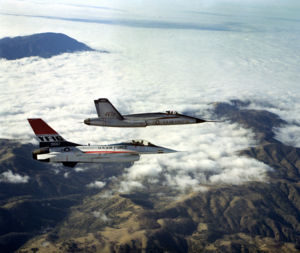PlaneSpottingWorld welcomes all new members! Please gives your ideas at the Terminal.
Light Weight Fighter
The Light Weight Fighter (LWF) Program was a U.S. Air Force technology evaluation program initiated in the 1960's by a cabal of officers and defense analysts known as the "fighter mafia". It was spurred by then Maj. John Boyd's Energy-Maneuverability (E-M) theory of maneuverability, which indicated that excessive weight would have severely deblilitating consequences on the maneuverability of an aircraft. The new aircraft was to be a light day fighter with a high thrust-to-weight ratio, a gross weight of less than 20,000 pounds (half that of its counterpart, the F-15 Eagle), and high maneuverability.[1] It resulted in the development of the YF-16 and YF-17; the latter would be adopted by the U.S. Navy as the F/A-18. Late in the program, in 1974, with the promise of European sales, the Air Force changed the program name to Air Combat Fighter (ACF), and committed to purchasing 650 models of the YF-16, adopted as the F-16 Fighting Falcon.
History
In the 1960's, both the U.S. Air Force and U.S. Navy were in the process of acquiring large, heavy fighters designed primarily to fight with missiles. Project Forecast, a 1963 Air Force attempt to identify future weapons trends, stated that Air Force needs for the next 20 years would be met by missile-armed variants of the F-111 and F-4, and that a counterair force must be able to destroy aircraft in the air at long ranges using advanced weapon systems.[1] Their F-X fighter acquisition program, initially merged into the TFX program, was written along those lines. Based on the work of John Boyd and his E-M theory, the Air Force proposal was quietly rewritten to reflect his findings, dropping a heavy swing-wing from the design, lowering the gross weight from 60,000+ pounds to slightly below 40,000, and the top speed to Mach 2.3, from 2.5. However, while Boyd's contributions were significant, he felt that it was still a compromise.[2]
Boyd, defense analysts Tom Christie and Pierre Sprey, and test pilot Col. Everst Riccioni formed the core of the self-named "fighter mafia" which worked behind the scenes in the late 1960s to pursue a lightweight fighter as an alternative to the F-15. In 1969, under the guise that the Navy was developing a small, high-performance Navy aircraft, Riccioni won $149,000 to fund the "Study to Validate the Integration of Advanced Energy-Maneuverability Theory with Trade-Off Analysis". This money was split between Northrop and General Dynamics to build the embodiment of Boyd's E-M theory - a small, low-draw, low-weight, pure fighter with no bomb racks. Northrop demanded and received $100,000 to design the YF-17; General Dynamics, eager to redeem its debacle with the F-111, received the remainder to develop the YF-16[2].
The Air Force had considered a similar concept earlier. In 1965, the Air Force had pusued a low-priority study of a lightweight Advanced Day Fighter (ADF), a 25,000 pound fighter. But it was shelved in 1967 in order to focus work on the F-15, designed to counter the Soviet MiG-25 'Foxbat'. Defense Secretary Melvin Laird and Deputy Defense Secretary David A. Packard, who entered office with the Nixon administration in 1969, were interested in these studies and threw their support behind the notion. In May 1971, Congress issued a critical report of the F-14 and F-15 and advocated spending $50 million on developing an alternative lightweight fighter. This was followed by the assignment of $12 million in the 1972 fiscal year budget for the LWF. On 6 January 1971, an RFP was issued to industry for a 20-000 pound fighter to complement the F-15[1] . Sprey insisted on a fly-off between two prototypes, as he had earlier on the A-X program, pitting the planes against MiG-17 'Frescos' and MiG-21 'Fishbeds' kept at Nellis, and an F-4. Furthermore, the evaluating pilots would not be test pilots and each would each fly both airframes.
Of the five manufacturers that submitted proposals - Boeing, General Dynamics, Lockheed, Northrop, and Vought, Vought (submitting the V-1100) and Lockheed, with the CL-1200 Lancer, were eliminated in March 1972. Though the Boeing Model 908-909 was initially most favored, it was quite similar in technology and appearance to the cheaper General Dynamics Model 401-16B. Since one of the goals of the program was to validate emerging technologies, Secretary of the Air Force Robert Seamans chose to select the General Dynamics and Northrop entries.
The fly-off commenced in 1974 as both prototypes were delivered. Concurrently, Belgium, Denmark, Norway, and the Netherlands had formed the Multinational Fighter Program Group (MFPG) to select a replacement for their F-104s from among the Dassault Mirage F.1, YF-16, YF-17, and Saab JA37 Viggen. They indicated that the winner of the LWF contest would be the favored candidate. Up to this point, the LWF was merely an evaluation program with no plans to purchase models, but the possibility of a European order lead the Pentagon to reconsider. The Air Force was now seeking a multi-role fighter to replace the F-4 and F-105, so the program was renamed the Air Combat Fighter (ACF). In September 1974, the Air Force announced plans to purchase 650 ACF's. On 13 January, 1975, Secretary of the Air Force John McLucas announced the selection of the YF-16[1].
References
- Michel, Col. Marshall. The Revolt of the Majors: How the Air Force Changed After Vietnam (and Saved the World). MIT Security Studies Program.
- Hehs, Eric (April/July 1991). Harry Hillaker — Father of the F-16. Code One: An Airpower Projection Magazine.

